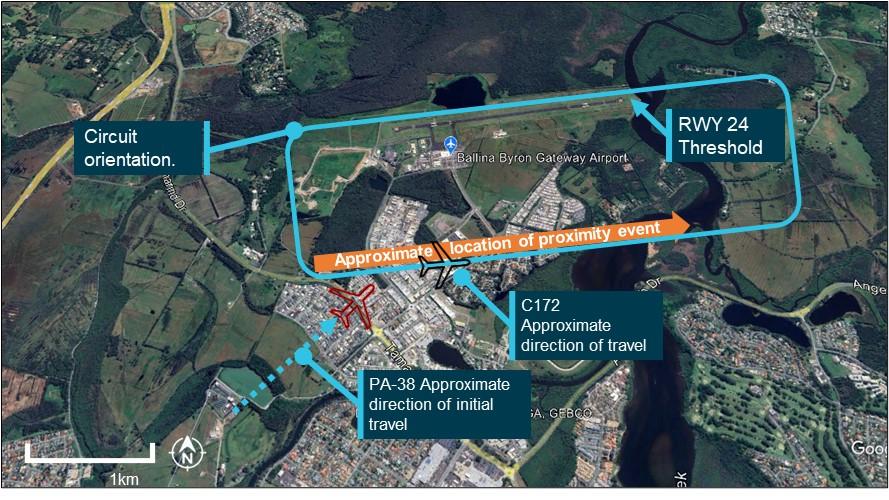What happened
On the afternoon of 21 June 2024 at about 1400 local time, a student pilot of a Cessna 172N (C172) was conducting solo circuits from runway 24 at Ballina/Byron Gateway Airport. A Piper PA‑38 (PA-38) operating under visual flight rules, approached and joined the circuit from the south (Figure 1).
The pilot of the PA-38 reported that they made an inbound call 15 NM from Ballina Airport at 2,500 feet, with an additional broadcast approximately 30 seconds before they turned onto downwind.
The C172 received a close proximity warning issued from the Ballina Surveillance Flight Information Service[1], and subsequently the pilot of the C172 conducted urgent manoeuvres on downwind to maintain separation with the PA-38 which passed about 100 feet above.
Figure 1: Ballina Airport circuit

Source: Google Earth, annotated by the ATSB
The majority of aerodromes within Australia operate without the provision of air traffic control services. These aerodromes rely upon pilots broadcasting their positions and intentions on a common traffic advisory frequency (CTAF) and then implementing separation actions that are agreed directly between the pilots. VHF radio is the primary communication tool to provide ‘alerted see-and-avoid’, used commonly across aviation from sport and recreational flying to air transport. The En Route Supplement Australia for the Ballina/Byron Gateway Airport requires mandatory broadcasts, when arriving, departing and transiting the area.
These positional broadcasts are a one-way communication and rely on the accuracy of the information being broadcast and the ability of other traffic receiving, comprehending and reacting to this information. They are intended to provide a short and concise broadcast to minimise radio channel congestion. However, they do not imply receipt of information by other parties unless direct radio contact is made between stations to acknowledge the traffic, confirm intentions and, if required, discuss measures to provide deconfliction.
The pilot of the C172 reported a lack of clear communication likely resulted in a degradation of situational awareness between the pilots.
Safety message
This occurrence illustrates the hazards associated with operations at non-controlled aerodromes and reinforces the importance of pilots being thoroughly familiar with the recommended procedures, the likely traffic mix and maintaining good situational awareness in the vicinity of an aerodrome. The practice of ‘alerted see and avoid’ relies on pilots making regular and clear radio calls, maintaining lookout and paying attention to the calls being made by other pilots sharing the same airspace to build situational awareness.
The most hazardous area for collisions is within 5 NM and up to 3,000 feet above an aerodrome where there are many tasks during the preparation for landing, including configuring the aircraft, completing checklists and communicating with other airspace users. Early completion of checklists and aircraft configuration changes will help to minimise distractions and enhance situational awareness and lookout at this critical time.
The ATSB’s publication A pilot’s guide to staying safe in the vicinity of non-controlled aerodromes outlines many of the common problems that occur at non-controlled aerodromes, and offers useful strategies to keep yourself and other pilots safe.
The Civil Aviation Safety Authority's Pilot Safety Hub also has extensive information on non‑controlled operations.

The ATSB SafetyWatch highlights the broad safety concerns that come out of our investigation findings and from the occurrence data reported to us by industry. One of the current safety concerns is Reducing the collision risk around non-towered airports. As well as additional guidance highlighted through Communication and self-separation in non-controlled airspace.
About this report
Decisions regarding whether to conduct an investigation, and the scope of an investigation, are based on many factors, including the level of safety benefit likely to be obtained from an investigation. For this occurrence, no investigation has been conducted and the ATSB did not verify the accuracy of the information. A brief description has been written using information supplied in the notification and any follow-up information in order to produce a short summary report, and allow for greater industry awareness of potential safety issues and possible safety actions.
[1] An SFIS provides a pilot with traffic information within a mandatory broadcast area using the aerodrome’s Common Traffic Advisory Frequency. The SFIS is not a separation or sequencing service.


